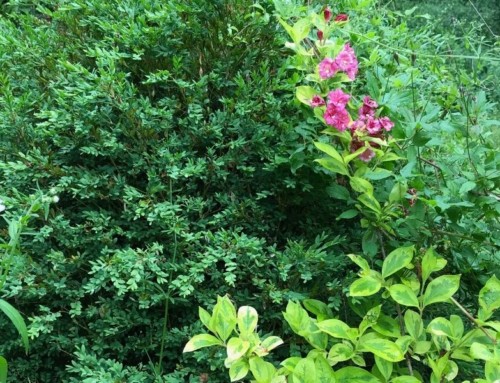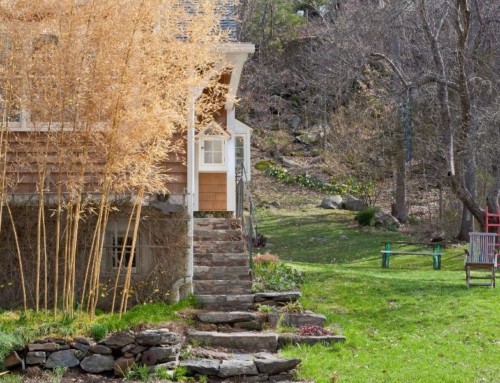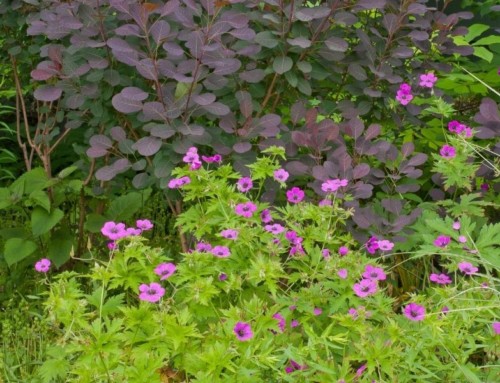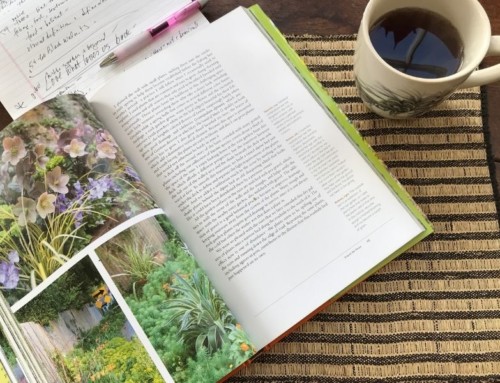I’m always searching for new ways to garden more sustainably, more restoratively. Muddling around in my own garden only goes so far. I need to go places.
After 6 months of social distancing, I really missed photographing gardens and visiting my favorite gardens and gardeners.
Gardeners are so generous, and we all learn so much from each other.
So I called my old friend Nancy DuBrule-Clemente of Natureworks and asked if she’d make me a cup of coffee and sit in her garden a bit to catch up with each other – at an appropriate distance – one mid-September Sunday morning.
We dove right into the conversation we started about 50 years ago.
That day’s back-and-forth centered on our struggle between planting as many native plants as possible to support the entire life cycle of diverse co-evolved wildlife, versus planting ornamental plants that just give us joy, even if they’re not native.
The two are not mutually exclusive.
At a time of year when many gardens are limping along, Nancy’s are as exuberant as she is, She has enough flowers to feed wildlife and cut for arrangements too.
Her gardens are full of color, with plants ranging from out of fashion long enough to be considered back-in-style heirlooms, to the latest introductions (temptations are many when you work at a standout garden center).
Nancy’s gardens are also bursting with plants that have self-sown over the years – with her encouragement and ruthless editing. They’re teeming with bees, butterflies, beneficial insects and birds.
Annuals and tender perennials (sold as annuals) are her September superstars. They fill the gap before perennial native asters join the show with great aplomb.
Many are varieties of plants native to southwestern US, Mexico and other parts of Latin America that really hit their stride in the heat of late summer.
Insects and birds in her gardens were too busy feeding on these plants to notice that they’re not native to Connecticut.
THE WHAT, WHY AND HOW OF NANCY’S LATE-SEASON ANNUAL SUPERSTARS
Italics are Nancy speaking, my comments are in roman type.
Garden Balsam (Impatiens balsamina cvs.)
(Shown in the photo at the top of the page)
Nobody grows it anymore. I first saw it at elderly couple’s yard next door when I lived in East Haven. It was coming up through the cracks of their patio.
I finally found seeds at Baker Creek or Select Seeds (both carry them). Winter is when you buy all this stuff you never plant, but I’m glad I planted balsam. It draws a ton of bees and is the perfect flower shape for hummingbirds.
Snapdragons (Antirrhinum cvs.)
I LOVE that I can plant them in April and they go through November. I’m really busy, so when I plant in spring and they’re still going in fall, I’m a happy camper.
They’ve even overwintered in a sheltered place on occasion.
(Southerners plant them in the fall. I called a friend in Texas one snowed-in winter to ask how her schemes for more winter interest worked out. Her reply – “oh, it’s just your usual winter annuals like snapdragons” – brought on a stab of envy.)
I wasn’t a big fan until I found out that they’re pollinated by bumblebees. Now I plant them near tomatoes and blueberries, also pollinated by bumblebees and deadhead them by snapping spent flowers off so they’ll keep blooming.
Mexican Sunflowers (Tithonia rotundifolia)
I’m not far from the Connecticut coast, on the monarch shoreline migration route.
They fly into my yard in the afternoon and flock to the Tithonia (and zinnias), then roost in the trees.
Hummingbirds and bumblebees love them too.
I realized in July that I didn’t have any Tithonia. I couldn’t buy plants anywhere, so I took a chance and planted a pack of seeds from High Mowing. Even though the package directions said 85 days, they got going fast in hot weather.
In mid-September, they were blooming – right at monarch migration time.
(Nancy grows many milkweeds, the monarch’s exclusive larval food plant, both at home and at Natureworks. She and her staff scout for monarch eggs every morning, raise them to adulthood and release.)
A monarch butterfly was “born” right before our eyes as we drank coffee.
CLICK HERE for information and the Natureworks monarch raising slideshow.
Amaranth (Amaranthus cvs.)
I planted a red one 10-12 years ago and it’s still with me. It has self-sown all those years. I thin them out – probably leaving 1/ 30th of what appears – it gets BIG.
The orange amaranth – ‘Hot Biscuit’ is faded now. Goldfinches and other birds are all over it.
Sunflowers are ripening too and the birds are going back and forth between sunflowers and amaranth, eating seeds as they ripen.
(Plants with seeds that ripen over a long time keep birds coming back for more – they know where to find the good stuff without wasting energy.)
‘Hot Biscuit’ is dropping seeds too, so I bent one over, directing falling seed to a spot where I want them to self-sow in the border next to the garden.
Sunflowers (Helianthus annus)
I put black oil sunflower seed in my feeder years ago and they came up everywhere, an absurd amount.
Now I manage them. I recognize them as soon as they come up every year and pull out 95% of seedlings. They’ve moved from the courtyard, to the garden beds below; now they’re at the bottom of the garden and some are in the wayback.
(They’re huge, multi-branched and glorious, one of the top plants for pollinating bees.)
I limb them up so they don’t shade everything and stake them. When they get big I climb up a ladder with oak stakes and a small sledge hammer in hand, pound in the stakes and tie them up with natural twine.
In late July/August might limb them up even more (I do this with the amaranth too), to let in a window of light if, as happened this year, plants below aren’t ripening as they should.
And I plant escarole, slow-bolt lettuce, mesclun mix and other plants that benefit from the shade under them.
Zinnias (Zinnia cvs.)
I like big tall zinnias
- ‘Benary’s Giant’ from Johnny’s Seeds
- ‘Red Man Super Cactus’ a giant one with orangey fringe from Baker Creek
- ‘Giant Cactus Lilac Empress’, big purple one from Select Seeds
- ‘Zowie Yellow Flame’, a bicolor All America Selection
Also the Jazzy series – they’re smaller and look like embroidered starbursts, with intricate, delicate markings and ‘ Whirlygig Mix’ (18″ double and semi-double blooms in vibrant kaleidoscopic hues).
Butterflies, bees and hummingbirds like them all too!





